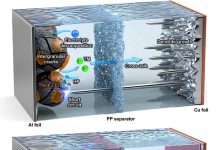
Lithium is at the heart of almost every rechargeable battery, from phones and laptops to electric cars.
But getting lithium out of the ground is slow, wasteful, and harmful to the environment. Most lithium today comes from saltwater deposits called brines.
Companies pump the salty water into huge evaporation ponds, where it can take more than a year to concentrate the lithium. The process uses enormous amounts of water—often in dry regions—and leaves behind large amounts of chemical waste.
Now, researchers at Rice University have come up with a new solution.
They have designed a special three-layer membrane that can filter lithium out of brines more quickly and with far less waste.
Their results, published in Nature Communications, suggest that this technology could make lithium production cleaner, faster, and more sustainable.
The new method works through a process called electrodialysis. When an electric current is applied, ions—charged particles—move across a membrane.
Normally, all positively charged ions, including sodium, calcium, and magnesium, pass through.
That’s a problem because these elements are far more common in brines than lithium. What makes the new Rice membrane special is its ability to let mostly lithium through while blocking the rest.
To achieve this, the team embedded tiny particles of lithium titanium oxide, or LTO, into the membrane. LTO has a crystal structure that happens to be just the right size for lithium ions to pass through, while larger ions stay behind.
The trick was figuring out how to blend LTO with the plastic-like material of the membrane without creating defects. The researchers solved this by adding amine groups to the LTO particles, allowing them to mix smoothly into a strong, even outer layer.
This design creates a tough, defect-free “skin” that makes the membrane highly selective for lithium.
In tests, it extracted lithium much more efficiently than traditional electrodialysis systems and used less energy. Just as importantly, the membrane held up well under stress, performing consistently even after two weeks of continuous use.
The project builds on more than a decade of work at Rice’s Nanotechnology Enabled Water Treatment Center, where scientists have been learning how to incorporate nanomaterials into membranes for water and resource recovery. Each of the three layers of the new membrane can be independently adjusted, making it a flexible platform that could be adapted to recover other valuable metals such as cobalt and nickel.
“Our goal was to create a material that extracts lithium with minimal environmental impact,” said Qilin Li, professor of civil and environmental engineering and one of the study leaders. “The design principles we developed also open the door to recovering many other important resources from waste streams.”
If produced at large scale, these membranes could slot into existing industrial systems, helping meet the growing demand for lithium while protecting scarce water supplies and reducing chemical waste. With cleaner technology like this, the future of batteries could be both powerful and sustainable.
Source: Rice University.



